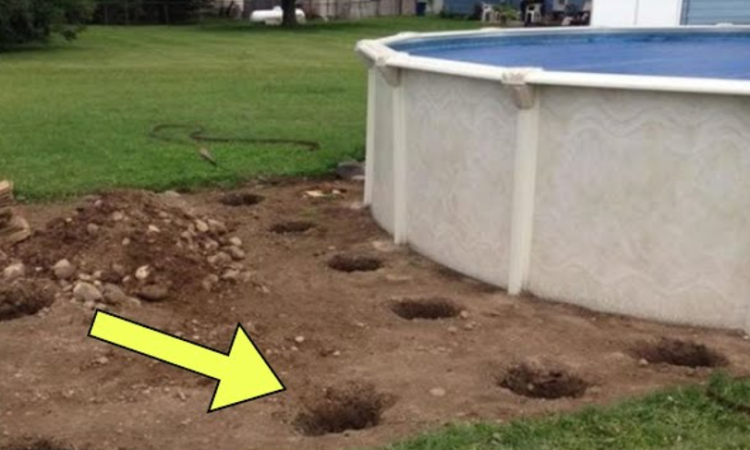
We all want to live the American dream. We want a big house, a yard for our kids and our dogs to run in, and a project that will be the envy of the neighborhood. Well, Wayne Martin had a house and a yard, and decided to get to work on a large-scale project to really set his home apart from the rest. So naturally, he started digging. While the rest of his neighborhood thought he was nuts, they quickly realized he had an amazing plan for his backyard. It’s pretty crazy what Wayne did with this giant hole, but it’s definitely one of the most ambitious projects we’ve ever seen.
The first thing I would have thought if I came across one of my neighbors digging a hole this size is that they have plans for an inground swimming pool. However, Wayne decided to fill that hole with something more than water. After laying down some gravel, he brought in something that definitely doesn’t fit in any pool. Neighbors quickly took notice once Wayne brought a 20-ft shipping container onto his lawn.
So before Wayne even started digging a hole, he went out and purchased a 20-ft shipping container. It’s pretty surprising how many of these giant containers you can find on the internet at incredibly affordable prices. The first step after purchasing his container was making sure to seal it shut. Instead of using the giant double doors, Wayne sealed them shut and instead installed a swinging door on the other side. He didn’t just seal those doors though; he made sure nothing could get in or out, especially leaks.
At this point, I think you know what he had planned for the container in the hole. But what was the goal of his project? Well, there’s a reason he wanted a bit of extra room above the container. Now that the container is in the hole, the real project begins. It might seem pretty obvious what Wayne has planned, but I guarantee the finished product will really inspire you to up your DIY game.
A sump pump is a piece of equipment used in plumbing that helps drain water out of enclosed spaces. This is a crucial piece of the puzzle when you’re putting anything below ground. It allows you to keep your bunker above the water line, so you generally find these in basements. The last thing you want for your underground bunker is for a flood to ruin anything you put inside it. But what was Wayne planning on putting inside his bunker exactly? The answer to that question is coming up in just a bit.
Naturally, when you’re making an underground bunker, you need to have a way to get inside it. Wayne did the logical thing and laid down a set of concrete steps, making sure the top stair was at the same level as the top of his bunker. Wayne was very smart to install two I-beams to ensure his bunker was as stable as possible. You probably wouldn’t think a giant 20-ft container could move much, but the ground could easily shift and leave his bunker unbalanced.
It’s kind of hard to think about a roof being underground, but that’s precisely the plan here. Wayne laid down heavy sheets of metal across the framework that is stable enough to support a person’s weight, and even a dog. Obviously, these are just the first steps to laying down the roof, but it gives us a great idea of what they had planned.
Now that the exterior was taking shape, we still need to know what’s going on inside the bunker. What’s he planning on putting in there anyway? We’ve already shed some light on how the staircase would be the only way in and out of the bunker, but Wayne wasn’t satisfied with just a regular entrance. Once he had the roof all set up and secure, he got to work making a grand entrance for his bunker. He left an opening from the roof and set up some rebar to help keep everything supported.
Obviously, Wayne took safety very seriously when putting together his bunker. Not only did he make sure that his bunker was safe and secure in the ground, but he also ensured everything was up to code. As crucial as it was to install a sump pump to make sure water could be filtered through the soil, the most important addition was the air vents. You probably won’t last very long underground without access to fresh air, so Wayne made sure to install two 12-inch air vents in the front and back of the bunker. The ground can move and shift, especially in the winter when it freezes, so Wayne made sure to encase his bunker in concrete along the sides as well as on top of the roof.
Now that he has his bunker set up to protect against anything life throws at it, he can get to work on the interior of the project. As the only part of the bunker that would have to deal with the elements, more protection is always better. That door is definitely going to take a beating over the years, so any way you can block out weather conditions or animals is the better option.
Now that he’s finally done with the outside, we can take a trip down those steps to see what the inside is like. As we’ve said time and time again, when doing a project like this, safety is key. The last thing you want is for your bunker to be sitting out in the middle of your yard in a dirt pit, so Wayne made sure to use some high-end soil to fill the space surrounding the entrance. This means he can go back once everything is done and plant some plants to help it blend in with the rest of his lawn. You can see that the finished product won’t even make it look like there was a giant hole there in the first place, and I doubt anyone will expect to find a bunker lying underneath.
I don’t know what I was expecting, but I certainly wasn’t expecting this cellar to be filled with wine. However, it makes a lot of sense. Wine, and other liquor — is that bourbon I see? — is best stored underground, and the cool atmosphere should help it last for generations to come. But is that the only reason he built this bunker, or does he have even bigger plans for this cellar?
The great thing about a container like this is that it can fit so many different needs. As you can see from the back, there is plenty of room for storage. While he has plans for filling it with wine, it could also be a great place to store Christmas decorations or non-perishable foods in case of an emergency. Imagine if something bad, like a natural disaster, happens. Now Wayne has a shelter built to meet his needs if he has to hunker down for a couple of hours or even a couple of days. And the best part is that it doesn’t take up any space in his yard because it’s all underground.
One of the most interesting aspects of Wayne’s project is that, with a little bit of money and some resources, anyone can do this themselves. Instead of creating his own secret bunker, Wayne decided to share his masterpiece with the world, down to how he created it. He even shared the specs of his container, noting the aspects builders will need to pay close attention to if they attempt to recreate it themselves. Wayne even provided some tips he learned along the way.
While Wayne was finished with his bunker, he shared a couple of tips or recommendations for people who might also try to install their own bunker. One of his suggestions is adding handrails down the stairs for security. Frankly, that’s a great idea, especially if you live somewhere cold where the stairs could get icy and slippery. Also, he said it might make sense to build a small overhang over the entrance. Again, this would be a great idea if you live somewhere where the elements could leave your stairs icy or fill the hole with rainwater. It wouldn’t be a bad idea to help keep critters out of your walkway either.
Although we’re not currently fighting a war on American soil, many people still have bunkers in their homes. During the Cold War, the federal government recommended people create fallout shelters and bunkers in their basements or backyards. They recommended using as much concrete as possible and building a strong roof. During the 1960s, the shelters weren’t designed very well, but now people have more access to information and resources.
So, how many Americans have bunkers today? In early 2017, container and bunker building companies saw their business greatly increase. Americans were compelled to prepare for a wartime situation as foreign relations tensions and uncertainty of the future grew. Clyde Scott, who owns Rising Bunkers, a bunker-building company based in Texas, said business was at an all-time high in 2016 to 2017. His sales increased an incredible 400%, according to The Independent, and grew to a $10 million-a-year business.
In the end, all of Wayne’s hard work came at a price, but it’s way more reasonable than you might think. All in all, Wayne spent $122,500 on his DIY bunker, which is insanely reasonable. He did mention that he did most of the work himself and had his own tractor, which likely helped with things like filling in the soil and even digging the hole in the first place. This is a resourceful way to go about creating a bunker. Other people are turning to emerging bunker companies that will help build one for you.
Paul C. D., the president and CEO of Utah Shelter Systems, says their bunker business has been very busy in recent years. Although his customers are all over the country, C. D. said the majority of orders come from New York, California, and Texas. He told Fox 13 that the smallest shelters start at around $50,000, while the largest shelters — typically 12ft x 50ft — run right around $100,000. Most customers are building the bunkers for their families and are able to deflect electromagnetic pulses and radiation.
Vivos XPoint is a decommissioned army base located in South Dakota
. It hasn’t been used since 1967, but now there are plans to utilize the war-era bunkers once again, this time for citizens. There are an incredible 575 concrete bunkers located off the grid in the grasslands near the Wyoming border, and they’re planning on building more. Bunkers here are available to lease for $225,000 for 99 years, plus $1,000 annually. They’re spacious at 1,590 or 2,120 sq ft, however, there’s no plumbing, electricity, or air filtration, so they need some work.
Atlas Survival Shelters, based in California, sold 30 shelters in 3 days when Donald Trump took office. Compare that to the 10 they sold in the entire year of 2011, and it’s easy to argue that interest has increased. The bunkers they create are designed to include the comforts of home. So, if you’re wanting to take shelter without feeling like you’re hiding in an unfinished basement, this is a good option. Many of their customers are baby boomers who remember the threat of a nuclear missile attack from their younger years and want to be prepared.




